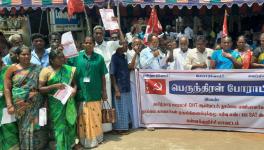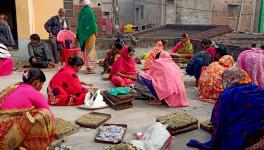Gujarat Workers Protest as Salt Pans Submerge Due to Diversion of Excess Water from Narmada
At Kharagoda in Surendranagar district of Gujarat, the entry point to the Little Rann of Kutch region, the salt farmers stood in ankle deep water in their salt pans, holding placards as they announced their decision to boycott local body elections as mark of protest. They claimed, each year excess water from Narmada is released in the area destroying their produce
“The salt production has gone down by 40% in the past five years due to flooding of the salt pans. Every year, excess water from Narmada is released in this area just before harvesting destroying the produce,” Bharatbhai Somara, a salt pan worker and member of the Agariya Hitrakshak Committee told NewsClick.
Little Rann of Kutch, a seasonal salty marsh land about 10 km from the Arabian sea in Kutch district of Gujarat is home to the Agariyas, the salt farmers of the region, who have been earning their livelihood by making salt for generations.
The Agariyas, as they are locally called, migrate each year during the month of September to Little Rann of Kutch after monsoon water has receded and stay till April or early May. They work relentlessly braving the weather conditions of the desert, till the salt is ready to harvest by April or May.
Also read: Gujarat Govt Shuts Down Rann Shalas in Kutch
Noticeably, Little Rann of Kutch, an area of about 440 square kilometre gets flooded every monsoon from the overflowing Banas, Khari, Rupen, Brahmani rivers of North Gujarat and Saurashtra region. However, the floodwater recedes by the onset of winters when the Agariyas migrate from different parts of Kutch and neighbouring Morbi and Surendranagar districts.
“Currently, there is about 1.5 to 2 feet water in the salt pans that has stretched 80 km inside the desert. This has been a phenomenon for the past four or five years now. This unseasonal flood has been occurring due to the mismanagement of Sardar Sarovar Narmada Nigam Limited (SSNNL). SSNNL releases excess water than the farmers of the region can use. As a result, excess water from Kutch branch canal is diverted into the deserts each year during this time,” Pankti Jog, a Gujarat-based activist working for rights of the salt workers, told NewsClick.
“This untimely flood for the past few years have been causing immense loss to the Agariyas, a denotified tribe whose only occupation has been salt farming. Around 6,000 families depend on salt farming for their livelihood,” Jog added.
“It takes two months to build a pata (salt pan) that begins with Agariyas pumping out the ground water and filling the pata so that natural process of evaporation leaves behind salt that is ready to be harvested. For six to seven months, Agariyas live in shanties near their salt pans. About 400 ton of salt is harvested at the end of the season. Since 2017, the harvest has been cut down by about half due to the untimely flood just before the harvest. A stretch of 140 pata in 80 km extending from Patdi to Halvad have been damaged due to flooding over the past two months. Each Agariya stand to lose salt worth around Rs 7 or 8 lakh,” Bharatbhai Somara said.
“We have met the officials of SSNNL and gave them applications in writing several times but in vain. Once in 2017, we were promised a compensation of Rs 9 lakh which we are yet to receive,” he added.
The Agariyas, who live in more than 100 villages around the Little Rann of Kutch, are reportedly one of the poorest communities in the state who have been largely left out of benefits of most welfare schemes of the state, according to them.
A CAG report tabled in the Gujarat Assembly last year stated that such a situation was owing to serious lapse in imposition of basic clauses to deter exploitation in leaseholder agreements as well as due to lack of inter- departmental coordination and long-term policy in the state.
Also read: We Know Modi Well, He Cannot Fool Us: Gujarat Farmers
The report stated, “There have been no attempts on improvement of the economic condition of salt workers and they continue to live in a hand-to-mouth condition.”
It further revealed, “Salt workers were not covered under the Swachch Bharat Mission. During visits to 17 salt units in Bhavnagar and Kutch between May to July 2019, it was observed that there was no toilet facility provided to the workers. Thus, the salt workers, particularly women faced difficulties and were deprived of privacy and hygiene.”
Noticeably, there is no condition to provide housing to salt workers in the salt lease leaving them either at the mercy of the salt unit owners for basic lodging or having to manage themselves.
The CAG report also said that, “The condition of providing toilets and bathrooms for hygiene and sanitation were not prescribed in the standard salt lease agreements prepared by the Industries Commissionerate or the Industries and Mining Department of Gujarat and neither were there any standard terms for medical facilities for the salt workers to be provided by the leaseholders. Thus, it was not mandatory for lease holders to construct toilets, bathroom or provide medical aid or even first aid to any salt worker working on site. Further there is no provision for medical insurance for the salt workers or their families.”
The audit report further observed, “There was neither any guarantee of payment of minimum wages, thus stripping workers of any protection against economic exploitation. Even the big salt units of areas upto 10 acres are not mandated to ensure welfare of the salt workers hired by them by implementing condition of minimum wages, provident fund and insurance by unit owners in their lease agreement.”
“Basic amenities such as drinking water, housing, sanitation, roads remain unfulfilled for the major part of the seven districts that the auditors looked into. A total of Rs 34.69 crore of fund sanctioned and allocated for the salt workers’ welfare remained unutilised during the years 2014 to 2019 and no expenditure was incurred on housing facilities,” the CAG report added.
Get the latest reports & analysis with people's perspective on Protests, movements & deep analytical videos, discussions of the current affairs in your Telegram app. Subscribe to NewsClick's Telegram channel & get Real-Time updates on stories, as they get published on our website.
























